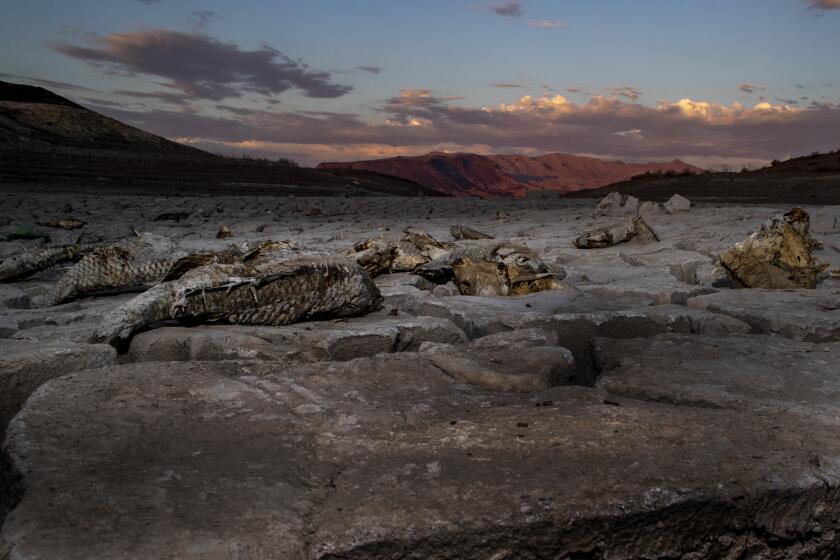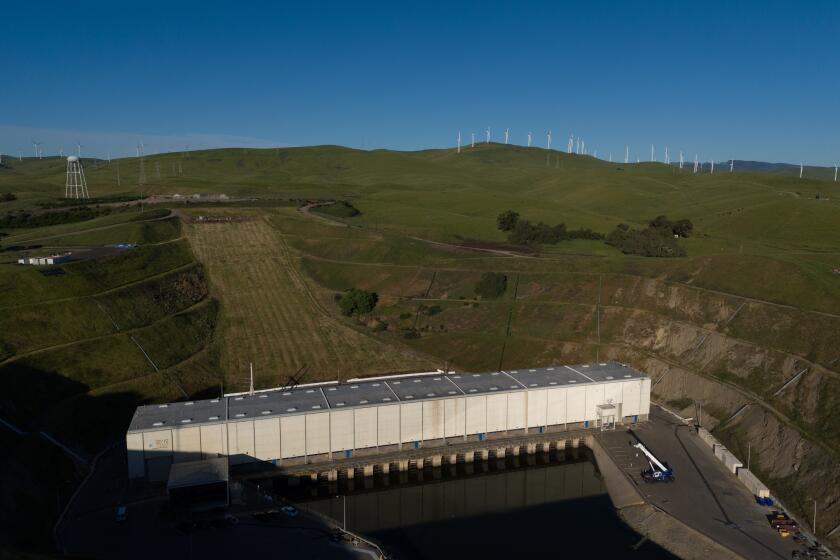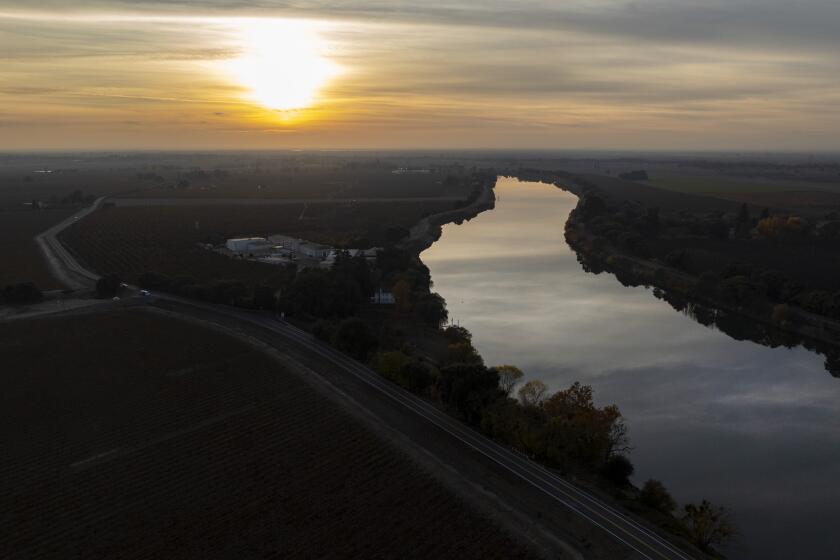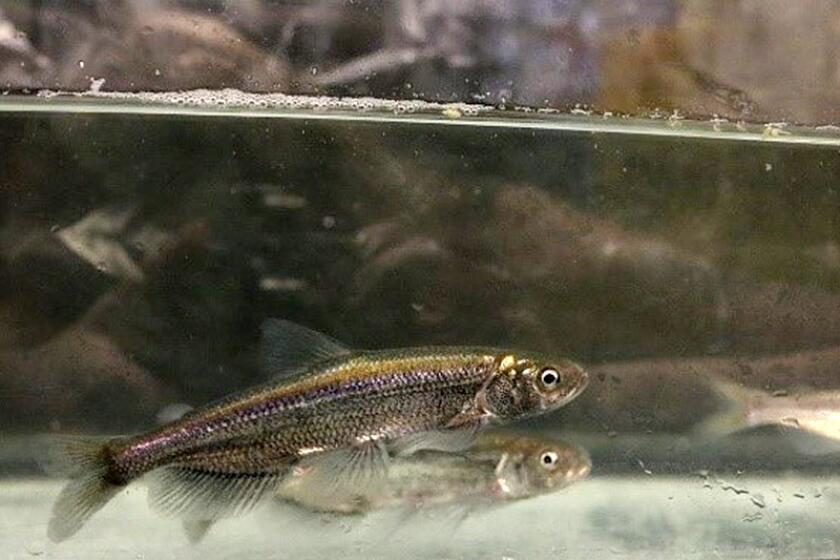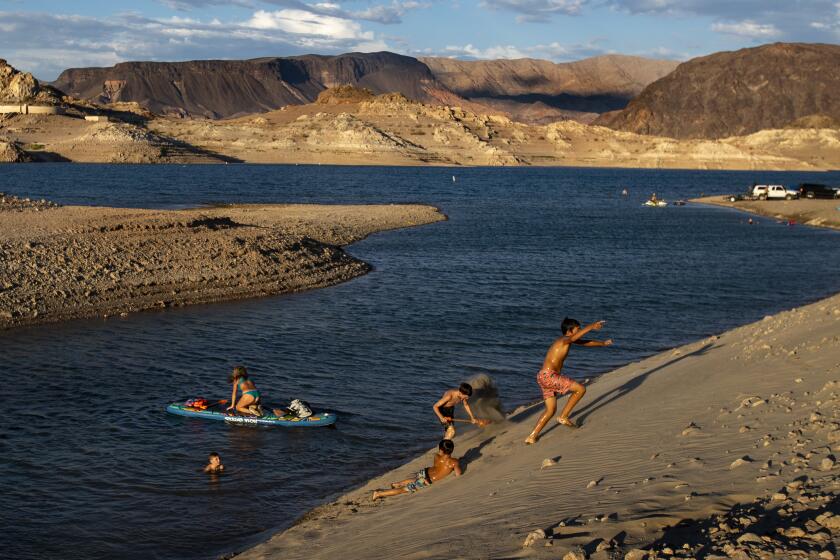
- Share via
Climate change threatens to dramatically shrink the amount of water California can deliver over the next 20 years and could reduce supplies available from the State Water Project by up to 23%, according to new projections released Wednesday by Gov. Gavin Newsom’s administration.
The analysis by the California Department of Water Resources examined a range of climate change scenarios and projected that by 2043 the average amount of water transported through the massive network of reservoirs and canals to more than half the state’s population could decline between 13% and 23%.
Such a loss in the State Water Project’s water delivery capacity, if not addressed, could lead to major shortages for much of the state, including Southern California.
“The SWP was designed for the climate of the 20th century,” said John Yarbrough, the project’s deputy director. “It’s going to need continued investment to get it in a place where it’s really able to function with the hydrology of the future.”
Even after a year and a half of wet weather, research shows the American West has experienced the driest 25-year period in 1,200 years. When might the megadrought end?
State officials analyzed how rising temperatures are likely to affect the existing water infrastructure without any adaptation measures. They said the expected losses in the system’s capacity show a need to invest in projects intended to boost supplies, such as the state’s plan to build the new Sites Reservoir and a water tunnel beneath the Sacramento-San Joaquin River Delta.
In addition to serving 27 million people, the State Water Project supplies roughly 750,000 acres of farmland.
According to the report, current infrastructure will be able to deliver less water in the coming years as rising temperatures bring more intense droughts, decreased snowpack, more extreme storms and more precipitation falling as rain rather than snow. Changes in the timing of runoff are also expected to create challenges. And sea level rise is likely to complicate water managers’ efforts to manage salinity levels and meet water quality standards in the delta.
The estimates were included in a report that the state publishes every two years. The last update in 2021 projected a 9% decrease in the State Water Project’s future water supplies because of climate change. The latest projections include a more detailed analysis of different climate scenarios.
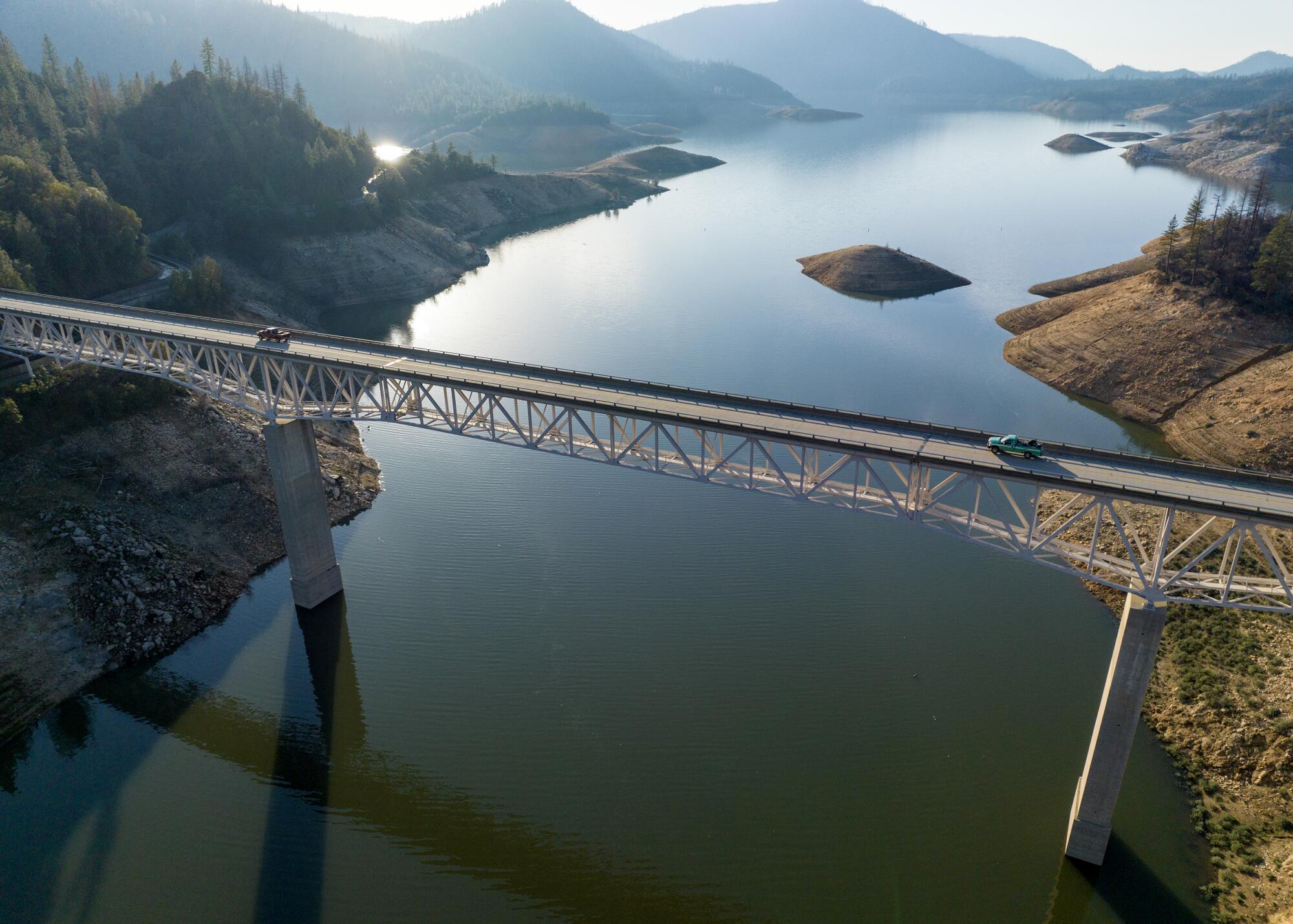
Newsom and other state officials have for years called for upgrading the state’s water infrastructure to adapt to warming driven by the burning of fossil fuels and rising levels of greenhouse gases.
In 2022, Newsom presented a plan calling for California to prepare for an estimated 10% decrease in the state’s water supply by 2040.
The State Water Project transports water across more than 700 miles through a series of reservoirs, aqueducts, pipelines and pumping plants from Northern California to Southern California.
The current infrastructure, which was built in the 1960s, includes massive pumps that draw water from the delta and send it flowing into the California Aqueduct. Water exports from the delta have decreased since 2008, partly because of changing regulatory requirements and protections for threatened fish species.
As California pumps water south, an elaborate operation focuses on rescuing fish. Lately, more fish have been arriving, forcing the state to pump less water.
State officials said that there is considerable uncertainty in future regulatory requirements and climate conditions, but that the analysis shows a large reduction of the water supply is likely. The more severe scenario would bring average losses of 496,000 acre-feet of water a year, enough to supply more than 1.7 million homes.
Karla Nemeth, director of the Department of Water Resources, said the analysis “underscores the need to modernize and upgrade our aging infrastructure so we can capture water supplies when it’s wet.”
In a letter presenting the report, Nemeth said the latest review “unmistakably demonstrates substantial reductions” in the project’s delivery capacity if no action is taken.
“Immediate action is imperative to address the impact of a warming climate,” she wrote.
A new analysis shows that building a California water tunnel would cost $20 billion. State officials say the project’s benefits would far outweigh the costs.
State officials have been taking steps to advance plans for the 45-mile water tunnel, which would create a second route to draw water from the Sacramento River into the aqueducts of the State Water Project.
In May, the Newsom administration announced that the cost of building the proposed tunnel is $20.1 billion, and that a state analysis concluded the projected benefits of the project would far outweigh the costs.
Opponents of the proposed Delta Conveyance Project have argued the state’s analysis is flawed and underestimates the costs while overestimating the benefits.
Jeffrey Michael, a public policy professor at University of the Pacific’s McGeorge School of Law, challenged the state’s financial estimates in a recent report, saying the state omitted substantial costs. His analysis found that building the tunnel would be significantly more expensive than other water supply alternatives.
Environmental groups, Indigenous tribes, fishing organizations and local agencies have filed lawsuits seeking to block the project.
Longfin smelt have suffered major declines in the San Francisco Bay estuary. Now the federal government has declared the fish an endangered species.
Conner Everts, a leader of the Environmental Water Caucus, said cost-effective solutions lie not in building big projects such as the tunnel or Sites Reservoir, but rather in promoting more conservation efforts and developing local water supplies to reduce reliance on water pumped from across the state.
“I think we need to focus on maximizing local water resources and further reducing demand,” Everts said. “It doesn’t make any sense to invest in the wrong place, invest a huge amount of money when there isn’t going to be water available.”
He pointed out that Californians have substantially reduced water use in cities in recent years. And researchers with the Pacific Institute, a water think tank, have estimated that California could reduce urban water use by more than 30% by investing in measures to use water more efficiently, as well as capturing more stormwater and recycling more wastewater.
Peter Gleick, the Pacific Institute’s senior fellow and co-founder, said state officials are drawing the wrong conclusions from the analysis by doubling down on multibillion-dollar projects like the tunnel and Sites, “which seem certain to have less water to allocate in the future, and which do nothing to protect threatened Bay-Delta ecosystems.”
“Instead, that same money would be far better spent on efficiency improvements, ecosystem restoration, strategies to capture stormwater in Central Valley aquifers in wet years, and wastewater treatment and reuse,” Gleick said.
“The new study shows we need dramatically new thinking about water,” he said. “Instead of doubling down on the failed water policies of the 20th century, the Newsom administration has the rare opportunity to pivot to new approaches and a new vision for California water.”
New research examines how much global warming has sapped the Colorado River since 2000. It shows the region has lost more water than Lake Mead can hold.
State water officials this year adopted regulations requiring urban suppliers to meet conservation goals, a change that is projected to save 500,000 acre-feet of water annually by 2040.
The state Department of Water Resources is also supporting other efforts to bolster supplies through water recycling, groundwater recharge and desalination.
In a separate ongoing review, state water officials say they are analyzing various climate adaptation strategies for the State Water Project, including the tunnel, water storage above ground and underground, and changing reservoir operations based on improved forecasts.
Yarbrough said that although the state’s analysis looks at a scenario of doing nothing, “we really can’t do nothing.”
“The water’s there. It’s just showing up in these much more intense, shorter time periods followed by longer time periods of drought,” he said. “We’ve got to look at how can we be prepared for what we’re going to see here in the next hundred years.”
Toward a more sustainable California
Get Boiling Point, our newsletter exploring climate change, energy and the environment, and become part of the conversation — and the solution.
You may occasionally receive promotional content from the Los Angeles Times.
